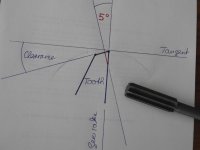forrest, are you there? anybody?
https://www.practicalmachinist.com/...ing-oversize-75483/?highlight=reamer+oversize
https://www.practicalmachinist.com/...ing-oversize-75483/?highlight=reamer+oversize
Follow along with the video below to see how to install our site as a web app on your home screen.
Note: This feature may not be available in some browsers.
i want it to cut undersize and want to make sure i stone in the right place.
If you really need to ream and hold a certain size within a couple-few tenths, just order over under reamers until you get the desired size. Sure, it can get expensive, but reaming is like black magic to hit *the* size. Coolant, oil, feed, rpm, stock left, all play into effect....
Yes he's saying to just very gently add a 5° (or less) negative rake as a small land - small as in barely visible - just enough to see the glint when the light reflects off it. This will help prevent the reamer from biting in so hard and will also help make it cut ever so slightly smaller. Only do this if the reamer is cutting larger than it measures or if you need to clean up some light damage. And I stand by my recommendation on that thread (from 2006?!) of not touching the edge with a reamer if you don't understand exactly what you're attempting to do...
Take care to check the outside land after stoning also, if a burr is raised you'll need to remove it. Carefully. Many new HSS tools come with a burr. If you check every tool you use and stone it carefully you can get some pretty substantially improved tool life.

Just try Forrest's method EXACTLY as he describes .. the negative rake on the cutting bevel reduces the reamer's tendency to 'hog' i.e. there is less tendency for the cutting edge to initiate a chip that goes deeper than the cylindrical surface of the reamer body,meaning larger diameter than the cylinder. That's the trick .. to prevent the over-enthusiastic 'bite' of a sharp reamer. Your diagram is correct. The reamer acts more like a scraper thusly treated.im thinking about grinding the end of the reamer between centers.
so should the red facet be stoned on the edge like this?
View attachment 301757
edit:
it is a 16 mm H7 reamer. H7 is 0/+18µ. reamer measures 16.013 in front and tapers back to 15.993. H7 reamers are standard, anything else is much more expensive. the hole it cuts with ethanol is 16.035. i used a 15.5 drill making a 15.7 hole and also bored to 15.6 mm. no difference. im looking to get a 16.005 hole.
so actally the reamer is cutting at the relieved corners only. my idea would have been to reduce the lands at the corners. any thoughts?
no idea if the lands are ground circular, if they are i cant see it. at the moment im only practicing for a 30 mm reamer ($$$). i getting the impression that a hand reamer would cut a smaller hole.
A 16mm reamer cutting 1.5 thou oversize outta the box?
I'd be looking at my setup/process before I started messing with the reamer.
Runout? SFM? Amount of stock removed? Cutting fluid/dry? Stop in the hole and retract? etc.
What material are you working with?
Notice
This website or its third-party tools process personal data (e.g. browsing data or IP addresses) and use cookies or other identifiers, which are necessary for its functioning and required to achieve the purposes illustrated in the cookie policy. To learn more, please refer to the cookie policy. In case of sale of your personal information, you may opt out by sending us an email via our Contact Us page. To find out more about the categories of personal information collected and the purposes for which such information will be used, please refer to our privacy policy. You accept the use of cookies or other identifiers by closing or dismissing this notice, by scrolling this page, by clicking a link or button or by continuing to browse otherwise.
